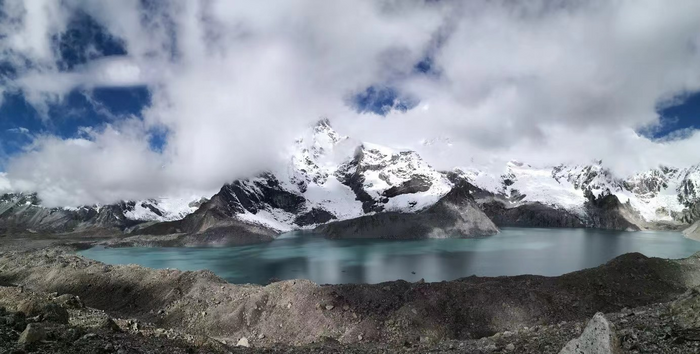The mass loss of lake-terminating glaciers in the greater Himalayas has been substantially overlooked due to satellites’ inability to see glacier changes occurring underwater, with major ramifications for the region’s future projections of glacier disappearance and water resources.
 Galong Co. Image Credit: Cheng Huang.
Galong Co. Image Credit: Cheng Huang.
The study, which was published on April 3rd, 2023, in Nature Geoscience, was carried out by an international team of researchers from the Chinese Academy of Sciences (CAS), the University of St. Andrews (UK), Graz University of Technology (Austria), and Carnegie Mellon University (USA).
An earlier assessment of the total mass loss of lake-terminating glaciers in the larger Himalayas was determined to be 6.5% understated, according to the researchers. The central Himalayas, where glacial lake expansion was the fastest, had the greatest underestimation of 10%. Galong Co in this region is an especially fascinating case, with a 65% underestimation.
This exclusion was partly owing to satellite imaging’s limitations in identifying underwater changes, which has resulted in a knowledge gap in the understanding of the actual extent of glacier decline.
Proglacial lakes in the region expanded by 47% in number, 33% in area, and 42% in volume between 2000 and 2020. This expansion resulted in an estimated 2.7 Gt loss of glacier mass, comparable to 570 million elephants, or more than 1,000 times the total number of elephants on the planet.
Earlier studies did not account for this loss since the satellite data used only measured the lake’s surface and not underwater ice that has been replaced by water.
These findings have important implications for understanding the impact of regional water resources and glacial lake outburst floods.
Guoqing Zhang, Study Lead Author, Institute of Tibetan Plateau Research, Chinese Academy of Sciences
Scientists can more accurately quantify the yearly mass balance of these glaciers compared to land-terminating glaciers by accounting for mass loss from lake-terminating glaciers, revealing the increased glacial mass loss across the larger Himalayas.
The study also demonstrates the need to understand the mechanisms underlying glacial mass loss, as well as the global underestimation of lake-terminating glacier mass loss, which is anticipated to be around 211.5 Gt, or roughly 12%, between 2000 and 2020.
This emphasizes the importance of incorporating subaqueous mass loss from lake-terminating glaciers in future mass-change estimates and glacier evolution models, regardless of the study region.
Tobias Bolch, Study Co-Corresponding Author, Graz University of Technology
According to David Rounce, a co-author from Carnegie Mellon University, in the long run, mass loss from lake-terminating glaciers might very well continue to be a major contributor to total mass loss throughout the 21st century, as glaciers with significant mass loss may disappear more quickly than current projections.
“By more accurately accounting for glacier mass loss, researchers can better predict future water resource availability in the sensitive mountain region,” added study Co-Author Tandong Yao, who also Co-Chairs Third Pole Environment (TPE), an international science program for the interdisciplinary study of the relationships among water, ice, climate, and humankind in the region and beyond.
Journal Reference:
Zhang, G., et al. (2023). Underestimated mass loss from lake-terminating glaciers in the greater Himalaya. Nature Geoscience. doi.org/10.1038/s41561-023-01150-1.